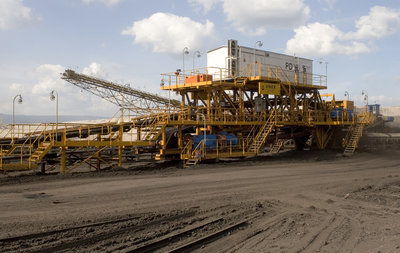Transport devices
Transport devices are intended for continuous transport of overburden, coal or extracted rock in open-pit mine conditions.
ZThe basic transport devices manufactured by UNEX Inc. are conveyors with rubber belts stiffened with textile or steel-cord meshwork. Belt width ranges from 1,200 to 2,250 mm and their max. transport capacity is up to 10,000 m3/h. Depending on the mining technology conveyors can be design in two versions: movable or immovable.
Driving and return stations can move on rails (in axis or fanlike fashion) using rails or caterpillar undercarriages (rigid or load sensitive).
For extreme conditions (contact pressure of lower than 0,07 Mpa) the driving and return station can be design by means of hydraulic walking undercarriages.
Adjusting and adapting every individual conveyor in accordance with customer requirements and technological conditions is a matter of course.
All parameters of transport devices are in-tune with a series of UNEX bucket wheel excavators. Together with additional equipment for loading, directing and deflecting material flow they form complete technological complexes. The conveyors are able to work in fully or semi-automatic mode. Maintenance costs are minimal.
Long-distance belt conveying
Long-distance belt conveying (LDBC) are intended for continuous transport of large amounts of different materials (e.g. overburden and coal in open-pit mines or other materials such as ores, phosphates etc.) predominantly for long distances. LDBCs form inseparable parts of mining complexes. They connect the first stage of mining – excavating and loading machines - with the final one – stacking machines or plants preparing the coal for transport.
LDBCs, designed and developed in UNEX, are characteristic by their simple and practical construction and by the use of progressive components and junctions – driving drums with ceramic linings, disc brakes made by Svendborg Brakes, a set of sensors automatically detecting the working condition of the conveyor, material flow and performing preventive diagnostics etc.
Belt wagons
Usage of belt wagons - special purpose movable devices - depends on the conditions of their use within the technological complex. Primarily they are designed for conveying material from the excavating machine to a transport device (conveying belt wagons) or for stacking material out of the charging hopper (stacking belt wagons). They enable operative or the transport lines to be temporarily enlarged or shortened and the difference in height of the overburden and coal seam to be resolved. They also are suitable for transcurrent transport and stacking and conveying material to removal facilities.
Discharging wagons
Discharging wagons are designed to continuously convey or discharge transported material at any place on the transport line. Their capacity is calculated in accordance with the belt width. Discharging wagons move either on a rail undercarriage (supplied including trackage) or caterpillar undercarriage (for belt widths of 1,800 mm and more).
Mobile hoppers
JMobile hoppers are designed for loading the transported material on belt conveyors at any place on the transport line. Their capacity is calculated in accordance with the belt width. Mobile hoppers move either on a rail undercarriage (supplied including trackage) or caterpillar undercarriage (for belt widths of 1,800 mm and more). Mobile hoppers are armoured and equipped with a bedplate absorbing impact energy.
For more information, contact our sales department:
Zdeněk Hurník
Director of Product Group
- E-mail:
- info__at__unex.cz
- Phone:

